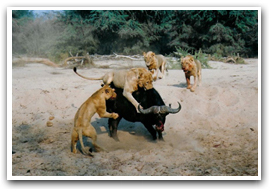Interactions Among Organisms: Introduction
Organisms in the environment do not live in isolation. They live in communities and interact in a variety of ways. Take a look at the following image of a community. How might organisms in this community interact with one another?
Directions: Click on each plus sign to read a description of some examples of interactions organisms in this community might have with one another.
There are three major types of interactions between organisms: competition, predation, and symbiosis. Let's take an in-depth look at each of these types of interactions.
Interactions Among Organisms: Competition
Competition occurs when individuals seek to obtain the same resource. For example, animals often compete for food or water. Animals also compete for space in which to find food, shelter, and opportunities to mate.
Plants compete for resources as well. Plants need light as an energy source for photosynthesis. Plants compete for sunlight, space, minerals, and water.
Unfortunately, there are often not enough resources to go around. Resource scarcity leads to competition between organisms in their environment.
Interactions Among Organisms: Predation
|
Virtually all animals, because we are not producers, must eat other organisms to obtain energy and nutrients. What are some things humans eat? We buy food in grocery stores, but if we were still hunting in the wild, we would be predators for food, capturing and feeding on other organisms. Predation is when one organism eats another. Predators can affect the size of prey populations in a community, and determine the places prey can live and feed.
|
 |
| Interactions between herbivores and the plants they eat is another important predator-prey relationship. An interaction in which one animal feeds on producers is herbivory. Herbivores can determine the places that certain plants can grow and survive. |  |
Interactions Among Organisms: Symbiosis
Any relationship in which two species live closely together is called symbiosis. There are three main types of symbiosis: mutualism, commensalism, and parasitism.
Let's take a closer look at these different types of symbiotic relationships.
Watch the following video on wasps and aphids to determine the type of symbiotic relationship they have.
Watch the following video on ants and caterpillars to determine the type of symbiotic relationship they have.
Interactions Among Organisms: Practice
Examine the following examples and determine what type of interaction is being described.